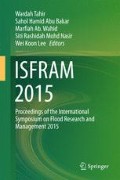Abstract
Water in Selangor is getting scarce, yet it is the key to its economic development. A fast-growing population and expanding industrialization in the state creates demands for new water sources and innovative management of water resources and services. The goal of this study was to calculate the impact on the supply—demand gap for the city and industry sectors in Selangor by the year 2050. To achieve this, two main simulations involving groundwater application using the Water Evaluation and Planning (WEAP) model, this, integrate an economic optimization model and a hydrology water management model. First simulation involves business as usual scenarios while the second incorporates the water saving measures into the simulation via the demand side management (DSM) analysis. Both simulations were carried out in the Selangor and Langat catchment as both catchments represent the main catchments for the state of Selangor. Such detailed simulation and inclusion of previously unaccounted for factors can help to create awareness of potential future problems, inform water practices, and suggest management alternatives. Results show that with the groundwater as an alternative resource and proper water saving measures, water deficit within Selangor can be significantly reduced.
Access this chapter
Tax calculation will be finalised at checkout
Purchases are for personal use only
References
Babel MS, Das Gupta A, Nayak DK (2005) A model for optimal allocation of water to competing demands. Water Resour Manage 19:693–712
Gleick HP, Cooley H, Cohen M, Morikawa M, Morrison J, Palaniappan M (2009) The World’s water 2008–2009: The Biennial report on freshwater resources. Island Pr, Washinton DC
Mohd Firdaus Hum NN, Abdul-Talib S (2015) Modelling water supply and demand for effective water management allocation in Selangor (in press)
Keshtkar AR, Salajegheh A, Sadodin A, Allan MG (2013) Application of Bayesian network for sustainability assessment in catchment modeling and management (case study: the Hablehrood river catchment). Ecol Model 268:48–54
Brouwer R, Hofkes M (2008) Integrated hydro-economic modelling: approaches, key issues and future research directions. Ecol Econ 66:16–22
Babel MS, Maporn N, Shide VR (2014) Incorporationg future climatic and socioeconomic variable in water demand forecasting: a case study in Bangkok. Water Resour Manage 28:2049–2062
Reca J, Roldan J, Alcaide M, Camacho E (2001) Optimization model for water allocation in deficit irrigation system: I. Description of the model. Water Manage 48(2):103–116
Bielsa J, Duarte R (2001) An economic model for water allocation in North Eastern Spain. Water Res Dev 17(3):397–410
Volk M, Hirschfeld J, Dehnhardt A, Schmidt G, Bohn C, Liershch S, Gassman PW (2008) Intergrated ecological-economic modelling of water pollution abatement management options in the Upper Ems River Basin. Ecol Econ 66:66–76
Harou JJ, Pulido-Velazquez M, Rosenberg DE, Medellin-Azuara J, Lund JR, Howitt RE (2009) Hydroeconomic models: concept, design, application and future prospects. J Hydrol 375:627–643
Rosegrant M, Cai X, Cline S (2002) World water food to 2025: dealing with scarcity. International Food Policy Research Institute (IFPRI), Washington DC, p 338
De Fraiture C (2007) Integrated water and food analysis at the global and basin level. An application of WATERSIM. Water Resour Manage 21:185–198
Maneta MP, Torres MO, Wallender WW, Vosti S, Howitt R, Rodrigues L, Bassoi LH, Panday S (2009) A spatially distributed hydroeconomic model to assess the effects of drought on land use, farm profits and agricultural employment. Water Resour Res 45:W11412
Ahrends H, Mast M, Rogers C, Kunstmann H (2008) Coupled hydrological-economic modelling for optimised irrigated cultivation in a semi-arid catchment of West Africa. Environ Model Softw 23:1327–1337
Jenkins MW, Lund J, Howitt R, Draper A, Msangi S, Tanaka S, Ritzema R, Marques G (2004) Optimization of California’s water supply system: results and insights. Journal of Water Resources Planning and Management 130:271–280
Qureshi M, Qureshi S, Bajracharya K, Kirby M (2008) Integrated biophysical and economic modelling framework to assess impacts of alternative groundwater management options. Water Resour Manage 22:321–341
Yates D, Sieber J, Purkey D, Huber AL (2005) WEAP21: a demand, priority and preferences driven water planning model: part 1 model characteristics. Water Int 30:487–500
Yates D, Sieber J, Purkey D, Huber AL, Galbraith H (2005) WEAP21: a demand, priority and preferences driven water planning model: part 2, aiding freshwater ecosystem service evaluation. Water Int 30:501–512
Bharati L, Smakhtin VU, Anand BK (2009) Modelling water supply and demand scenarios: the Godavari—Krishna inter basin transfer, India. Water Policy 11(Supplement 1):140–153
Blanco-Gutiérrez I, Vartega-Ortega C, Flichman G (2011) Cost-effectiveness of groundwater conservation measures: a multi-level analysis with policy implications. Agric Water Manag 98:639–652
Nash JE, Sutcliffe JV (1970) River flow forecasting through conceptual models part I—A discussion of principles. J Hydrol 10:282–290
Acknowledgement
The authors would like to express deepest gratitude to the International Foundation of Science (IFS) grant, Stockholm Environmental Institute (SEI) and Universiti Teknologi MARA (UiTM) Malaysia.
Author information
Authors and Affiliations
Corresponding author
Editor information
Editors and Affiliations
Rights and permissions
Copyright information
© 2016 Springer Science+Business Media Singapore
About this paper
Cite this paper
Hum, N.N.M.F., Abdul-Talib, S. (2016). Modeling Optimal Water Allocation by Managing the Demands in Selangor. In: Tahir, W., Abu Bakar, P., Wahid, M., Mohd Nasir, S., Lee, W. (eds) ISFRAM 2015. Springer, Singapore. https://doi.org/10.1007/978-981-10-0500-8_8
Download citation
DOI: https://doi.org/10.1007/978-981-10-0500-8_8
Published:
Publisher Name: Springer, Singapore
Print ISBN: 978-981-10-0499-5
Online ISBN: 978-981-10-0500-8
eBook Packages: Earth and Environmental ScienceEarth and Environmental Science (R0)

